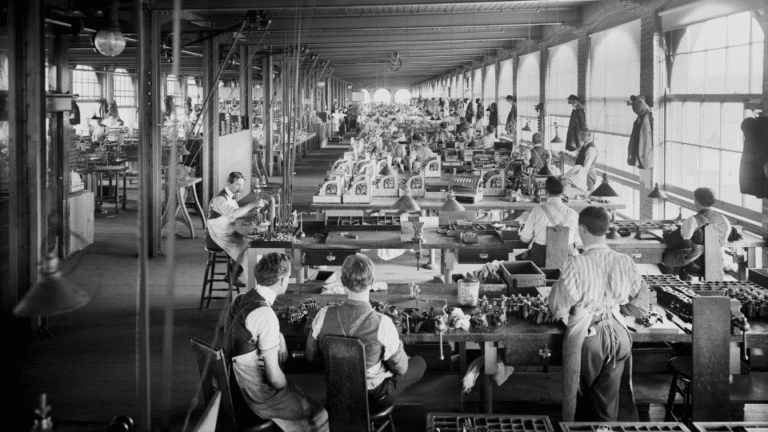When we think of l'innovation ouverte, we often picture digital platforms, AI-powered expert search tools, or crowdsourced problem-solving communities. Yet, the principles that define open innovation today—collaboration, shared knowledge, and collective problem-solving—are far older than the term itself.
In fact, their roots can be traced back to the 19th century, during one of the most transformative periods in human history: the Industrial Revolution.
Long before the internet, companies, engineers, and inventors were already engaging in what we would now call “proto-open innovation.” They exchanged ideas through correspondence networks, patent societies, and public exhibitions. In many ways, the 19th century created the social and economic foundations of open innovation as we know it.
A World Driven by Discovery
The 19th century was a time of explosive progress. Steam power, textile mechanization, railways, and later electricity transformed industries and societies. Yet this progress was not the result of isolated geniuses working alone in their workshops—it was the product of collaborative ecosystems.
Cities like Manchester, Birmingham, and Glasgow in the United Kingdom, or Paris and Lyon in France, became hubs of collective innovation.
Artisans, scientists, entrepreneurs, and investors gathered in cafés, societies, and workshops to exchange knowledge.
Innovation was not yet institutionalized; it was social, open, and often shared freely among peers.
One emblematic figure of this collaborative spirit was James Watt, inventor of the improved steam engine. Watt’s breakthroughs in efficiency were made possible through his partnership with industrialist Matthew Boulton, but also through a broader community of engineers, machinists, and chemists who exchanged ideas on metallurgy, mechanics, and energy.
Their collaboration foreshadowed the open innovation ecosystems of today—where universities, startups, and industry partners co-create technology.
Knowledge Societies: The 19th-Century Innovation Platforms
Before LinkedIn groups, Slack channels, or open innovation platforms like ideXlab, knowledge sharing took place through scientific societies and technical clubs.
These organizations functioned as early innovation intermediaries—bringing together diverse expertise around shared challenges.
The Lunar Society (1765–1813)
Based in Birmingham, the Lunar Society gathered the great minds of early industrial Britain: James Watt, Josiah Wedgwood, Erasmus Darwin, and Joseph Priestley.
They met under the full moon to discuss chemistry, mechanics, and philosophy—trading ideas that fueled the Industrial Revolution.
Their exchanges led to advances in everything from pottery glazes to gas lighting and steam engines.
Mechanics’ Institutes and Patent Clubs
Throughout the 19th century, Mechanics’ Institutes emerged across Europe and North America. These institutions were dedicated to spreading technical knowledge among workers and artisans.
They offered evening classes, libraries, and exhibitions—making innovation more inclusive et collective.
Similarly, patent clubs allowed inventors to share designs and seek improvements from peers, in a spirit closer to open source engineering than competition.
These societies acted as physical platforms for open innovation—connecting knowledge seekers and creators in an era before digital networks.
The Great Exhibitions: Crowdsourcing Before the Internet
If the Lunar Society was an early innovation network, the World’s Fairs of the 19th century were its global stage.
Le Great Exhibition of 1851 in London, held in the Crystal Palace, showcased over 100,000 inventions and industrial products from across the world. It was, in essence, the first global innovation marketplace.
Inventors displayed their work publicly, competitors observed and learned, and new partnerships formed on the spot.
Knowledge flowed openly: techniques were copied, adapted, and improved. While patent laws existed, enforcement was weak, and imitation often accelerated progress.
Par exemple :
- The exhibition popularized innovations in machine tools, telegraphyet textiles.
- International collaboration followed, as engineers shared blueprints and industrial methods across borders.
- Visitors, including entrepreneurs like Elisha Otis (the elevator pioneer), left inspired and better informed.
In today’s terms, the Great Exhibition was a crowdsourced knowledge event—a precursor to global hackathons and innovation summits.
Open Innovation Without the Name
The term “open innovation” would only be coined in the early 2000s by Professor Henry Chesbrough.
But its spirit—collaboration across boundaries, openness to external ideas, and shared development—was alive and thriving in the 19th century.
Shared Challenges, Shared Solutions
Industrial-age innovators faced common challenges: efficient power generation, safe transportation, new materials, and mass production.
They learned from each other’s failures and improvements, often publishing their methods in trade journals or presenting them at industrial fairs.
Early Intermediaries
Publishers, patent agents, and traveling engineers played a role similar to today’s open innovation intermediaries like ideXlab.
They connected inventors to investors, or factories to the latest technical know-how—spreading innovation across regions and industries.
Collaboration Over Competition
Even rival manufacturers often shared ideas informally. The textile mills of Northern England routinely exchanged techniques on spinning and dyeing, recognizing that improving quality and efficiency benefited the entire sector.
This collaborative mindset laid the groundwork for what we now call innovation ecosystems—networks of diverse actors who co-create value rather than working in isolation.
Lessons for Today’s Innovators
The Industrial Revolution’s approach to collaboration holds valuable lessons for the digital age:
- Innovation thrives in networks.
No major invention emerged from isolation. Success came from shared curiosity, discussion, and cooperation. - Access to knowledge matters.
Mechanics’ Institutes democratized learning—just as digital platforms now democratize access to expertise. - Public showcases drive progress.
The Great Exhibition accelerated innovation by making ideas visible and comparable. Today’s online innovation platforms do the same, connecting ideas with opportunities. - Collaboration fuels sustainability.
As we face climate and societal challenges, the 19th-century lesson is clear: progress depends on our ability to innovate together.
From Steam Engines to Digital Platforms: The Legacy Lives On
Today’s open innovation platforms—such as ideXlab—carry forward this long tradition of shared progress.
They transform what was once local and manual into something global and instantaneous.
Where 19th-century engineers gathered in workshops, we now gather in virtual spaces powered by AI, data, and connectivity.
The principle, however, remains the same:
Innovation happens faster when knowledge flows freely.
The Industrial Revolution’s inventors may not have known the term “open innovation,” but they practiced it instinctively—through conversation, collaboration, and curiosity.
Their legacy reminds us that progress is not about secrecy or isolation—it’s about the courage to share ideas and build together.
Conclusion
The Industrial Revolution was not only an age of machines—it was an age of connection.
Its inventors and thinkers laid the groundwork for today’s open innovation culture, proving that collaboration and shared knowledge have always been the true engines of progress.
From the moonlit meetings of the Lunar Society to the global showcases of the Great Exhibition, the story of open innovation began long before the digital age—and continues to inspire how we innovate today.










